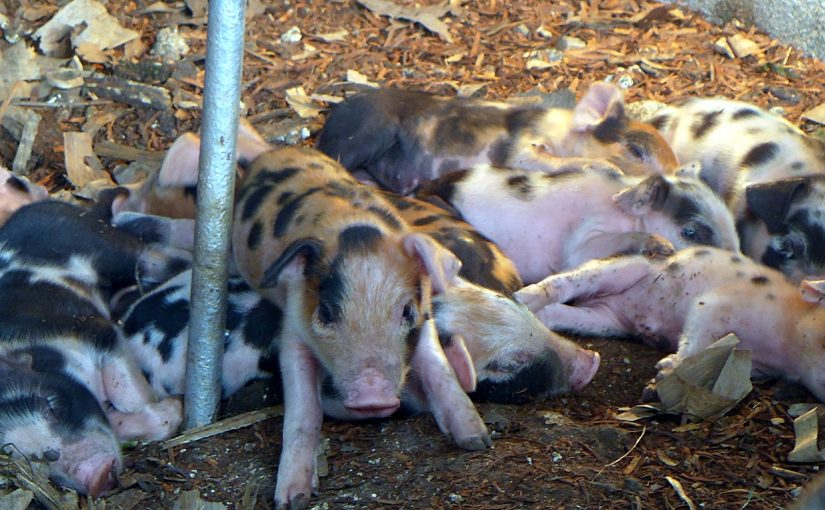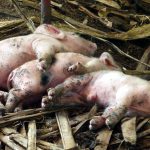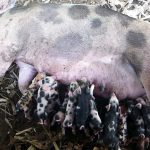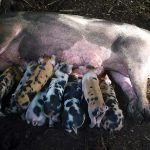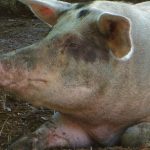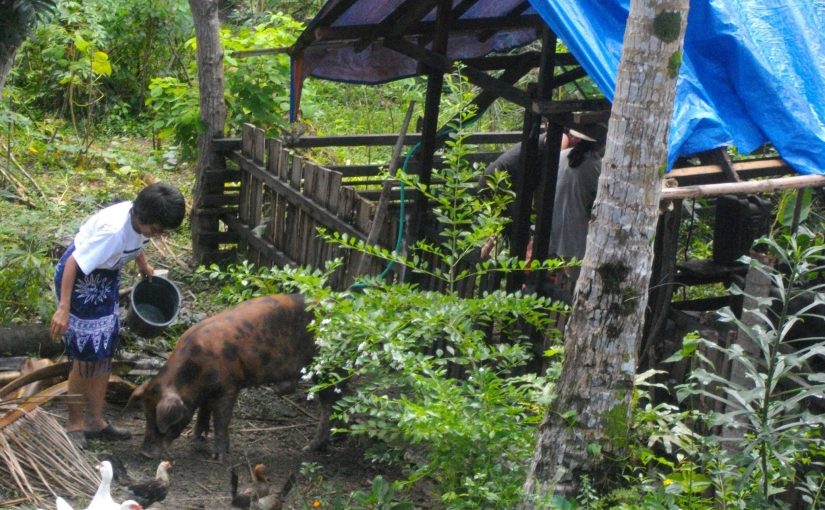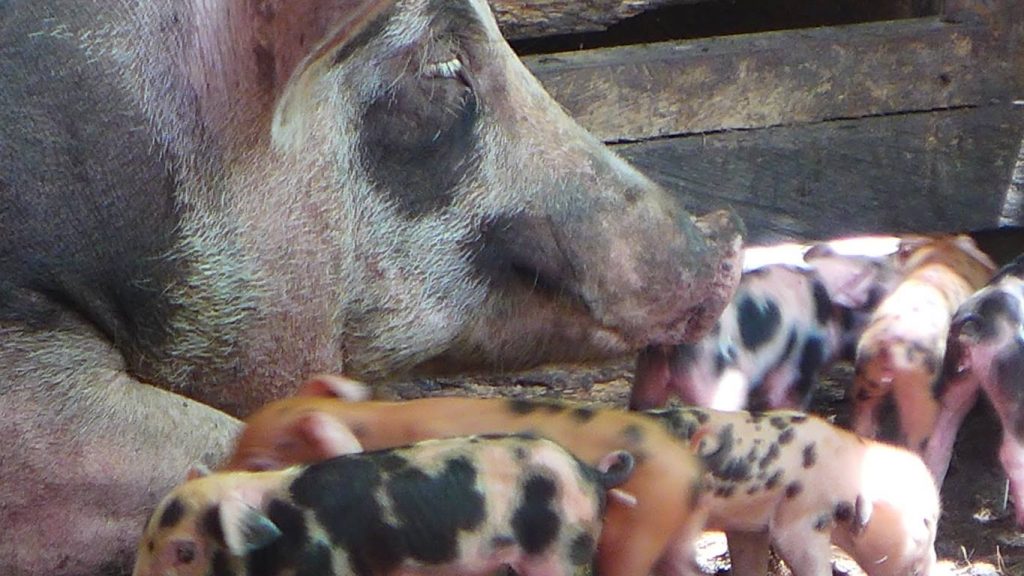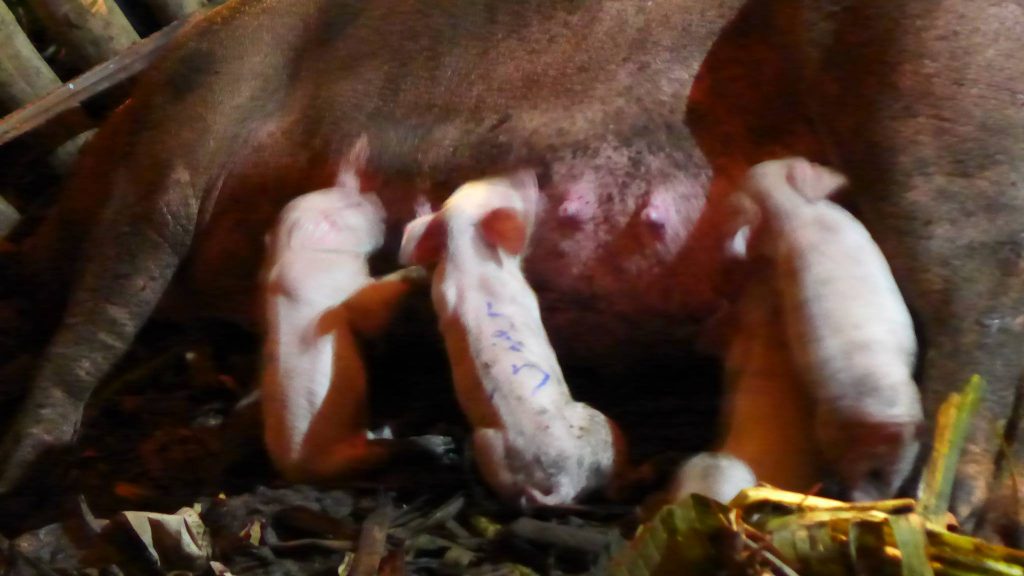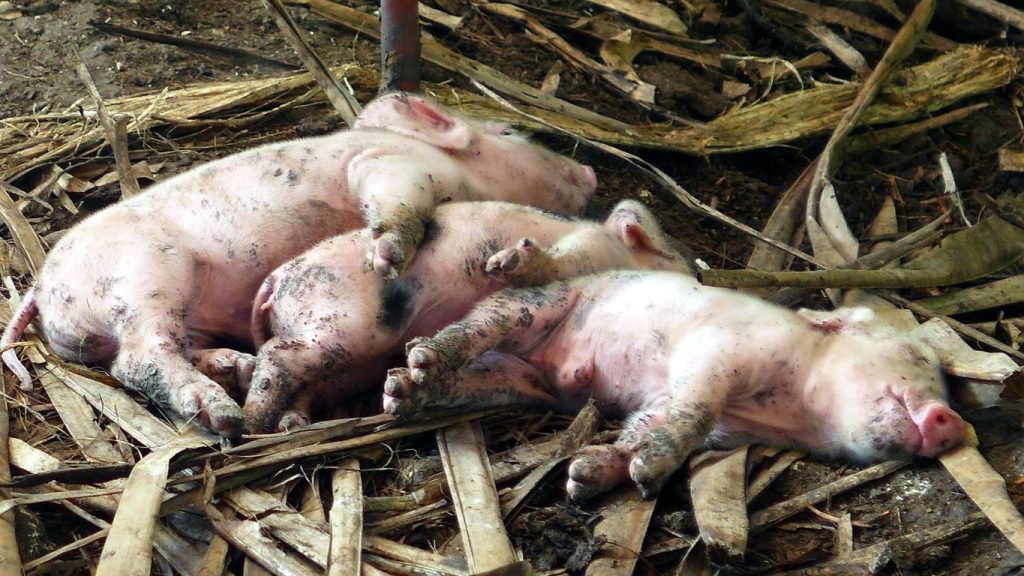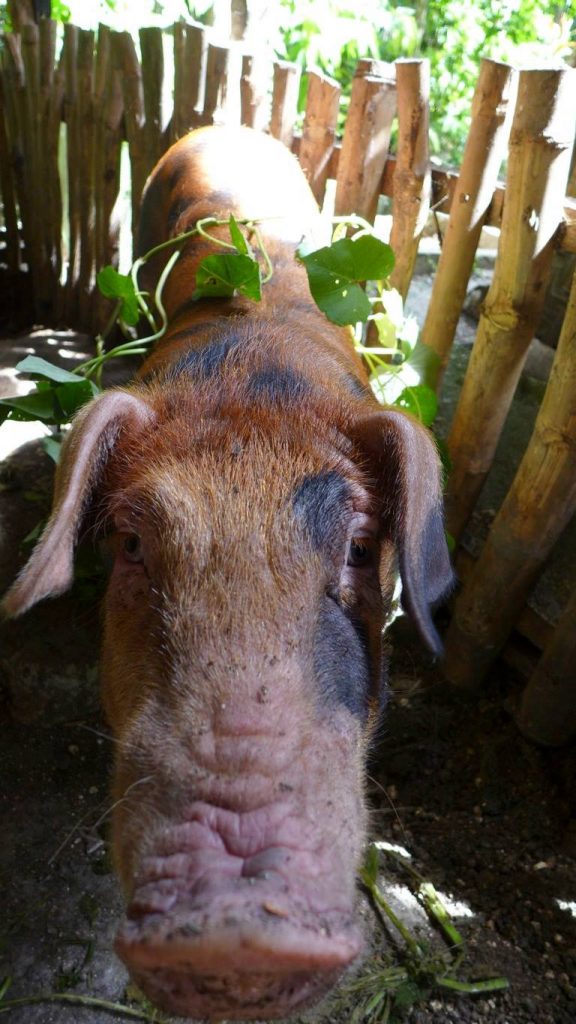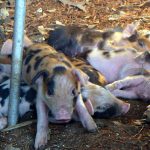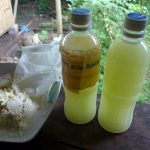This documentation is intended to study the behaviour of a sow (Auntie Brownie) and her piglets in a pen of size 240 square feet (22 square meters or 26 square yards). Auntie Brownie is 2 years and 6 months old and this is her second parity. The first parity was in June 18, 2017 and the second was in December 19, 2017.
Typical sow nesting behaviour (above). Dry banana leaves are the preferred nesting material in the tropics.
Auntie Brownie began expressing the need for nesting materials by pawing the ground (soil and wood chips). We gave her the dry banana leaves earlier collected for the purpose. She picked them up, placed them in a corner of the pen and shredded them. Nesting behaviour may take place between 6-12 hours prior to farrowing, other pigs may take as long as 2 days. Auntie Brownie took only about 5 hours. Then lay down and started the farrowing process.
In this video (above), the first two piglets born are vigorous and struggle to detach themselves from the umbilical cord and reach their mother’s teats. It takes a while for the piglets to attach to a teat, maybe between 5-15 minutes. Auntie Brownie lay down on the nest she built in a way that allows access to her teats.
In this video (above), eight piglets are born and Auntie Brownie is up moving the nesting materials around. This appears to be the mother’s way of “training” her piglets of her presence. In succeeding videos, Auntie Brownie commences nursing by moving nesting material about, signaling to the piglets her intention to lie down so that the piglets are aware of this and may avoid being crushed. Good sow instincts are supposedly indicated by nesting behaviour, pawing and moving the nesting materials about.
Here (above) are the eight piglets born within 2 hours (two more piglets were born at a later time we were unable to observe). Auntie Brownie is aware of a good lying position that allows access to all her teats. The piglets take their time to establish teat order.
Here (above) are all ten piglets at 16 hours of age. Teat order is established amongst seven of the piglets while three piglets are still unable to attach to their corresponding teats and therefore engage more in fighting. These are smaller piglets in the litter. Larger more dominant piglets often don’t engage in fighting during nursing. One large piglet on the right has mild milk scour. We notice this in a few piglets in previous litters during the first few days.
The piglets (above) call for milk and Auntie Brownie, obliges. The piglets are 7 days old in this video and have already been trained by the mother not to go near her side as she prepares to lie down. The safest place would be at her head or a good distance away.
Auntie Brownie tries to lie down carefully but she still lands heavily on her side (she was much more careful when the piglets were still unable to coordinate their movements with her). Notice one piglet on the left seem to have difficulty interpreting its mother’s call, it would’ve been crushed if it was closer to Auntie Brownie’s side. We usually call piglets like these “the wind-up toy” because they go oinking about before finding the mother’s teats. They usually grow up fine, catching up on the others. Some fail to thrive and die or are unable to move quickly and get accidentally crushed by the mother. Some piglets want more milk and one goes to the mother’s head to complain. Auntie Brownie decides they have had enough and she lies on her teats, pushing everyone off without hurting them. If a piglet gets trapped and it manages to squeal, Auntie Brownie will adjust her position. If a piglet is unable to squeal, then fatalities occur. If we see what has happened we can help and try to coax the mother to get up and move so the piglet can run away. Sometimes there is fighting during feeding and the piglets bite their mother’s teats with their sharp needle teeth.
Luckily, Auntie Brownie is a very patient sow: she growls when she is hurt and she will move to push off the piglets so she can adjust her position. This allows better teat access and fighting stops. After feeding, the piglets go out for a stroll in the garden, to poo and pee, and to play. This is when the mother can rest and relax. We made a piglet escape hatch on one side of the pen.
The following day, the second to the smallest piglet died, apparently of crushing in the night.
(Above) Auntie Brownie lies down a distance away from her 10-day old piglets. She calls the piglets and when they arrive, she adjusts her position to accommodate them. This is a much safer way of nursing piglets with less risk of crushing. The piglets sleep a distance away from the sow, in this case, the piglets have learned to sleep in the creep space provided. The creep space is attractive to the piglets not so much because of the lamp but because of the piglet escape hatch — the piglets are always excited to go out of the pen and into the garden for adventure. The “heating lamp” we are using produces bright light which distracts piglets. We will have to replace this with infrared heat lamps next time, although heating is really only needed when it rains during the cold season (December-March).
(Above) Auntie Brownie lies down and 10-day old piglets converge around her, waiting for the signal as to which side she will be lying on so they can coordinate their movement. Larger and more daring piglets now tend to access the teats before the mother could lie down, ignoring the mother’s attempt to get them to converge at her head by moving nesting material about. At this point, the role of nesting material in the nursing pattern is less important.
Auntie Brownie’s piglets, now 2 weeks old, playing (above). Pigs get excited whenever big rain comes. Notice the little piglet on the left – he’s a little bit slow and gets overwhelmed by the others quite easily, but is managing OK – he is the runt in the litter. Everyday, the piglets are allowed out to play in the garden but not today because of bad weather. They miss their garden adventure but are happy enough playing indoors instead!
Piglets here (above) are 18 days old. Auntie Brownie lies down very carefully. As mentioned earlier, piglets are now more daring and access the teats even when the mother has not yet laid down. The runt on the right side is unresponsive to the mother’s position or grunting calls. This is when crushing occurs. Since Day 1, the runt has had some troubles establishing good feeding regime with the mother and litter mates, although teat order has been established. The runt also seemed to have problems digesting its food, its belly was contracting rapidly and even if it had teat access it abruptly stops feeding and walks away slowly.
The runt died the same day this video was taken.*
(Above) Lying down and nursing behaviour well established, but sometimes Auntie Brownie changes her mind! 🙂 She has started to teach her piglets to sample solid food. The largest piglet began sampling mother’s food by age 5 days. Piglets here are 19 days old.
We hope this documentation is useful for those considering alternative gestating/farrowing systems. This system does not address group housing because we are only micro-scale.
* The piglet mentioned above died within an hour after drinking water with a small amount of molasses. Up to two-thirds of the sugar content in cane molasses is sucrose (glucose and fructose) and more in beet molasses. Sucrose is toxic to young pigs under 7 days of age. Since our piglet is 18 days old we considered it safe. However, this piglet may have health problems from the beginning as observed from its developmental condition since birth.
The problem with sucrose toxicity arises when there is low activity of intestinal sucrase in the intestine of young piglets. With fructose, the problem is that young piglets cannot effectively process (phosphorylate) fructose in either intestinal cells or liver. It is possible that the little runt has not developed properly in time to process molasses. So it is advised not to give molasses to young or compromised pigs.
